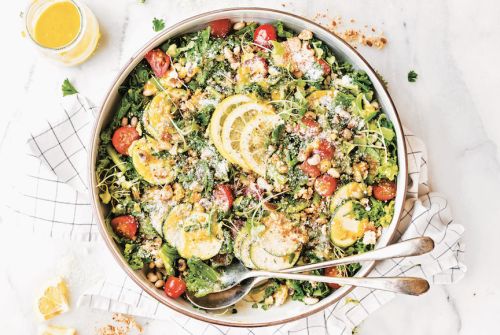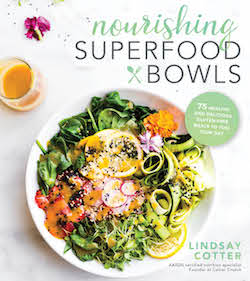Our editors independently select these products. Making a purchase through our links may earn Well+Good a commission
Lindsay Cotter, the certified nutritionist behind gluten-free food blog Cotter Crunch and author of cookbook Nourishing Superfood Bowls, knows a thing or two about reinventing the classics. With her background in sports nutrition—she’s certified by the American Academy of Sports Dietitians and Nutritionists—finding ways to health-ify clients’ favorites comes second-nature. Hey, she has serious athletes to fuel.
Here, Cotter applies her real foods philosophy to a recipe near and dear to her Southern heritage, the Caesar salad. “I love a good Caesar salad, but I often find it can be heavy without a lot of power nutrients,” she says. Power nutrients, according to Cotter, are the key to elevating a healthy bowl to superfood-status.
Her tricked out version uses vitamin K-rich mustard greens (good for bone health), black eyed peas (full of iron), and vitamin-C filled tomatoes and greens (which help absorb all that amazing iron).
By pairing nutrient-rich ingredients with those that help your body process said nutrients, you’re sure to get the most from your meals. Try your hand as a superfood chef with Cotter’s Caesar salad power bowl recipe, below.
Keep reading for the the recipe.
Southern Caesar salad power bowl
Serves 3
IngredientsFor the caesar dressing:
1 egg yolk1/2 Tbsp honey mustard3 to 4 Tbsp olive oil or avocado oil 1/4 tsp fine sea salt or kosher salt, to taste1/4 tsp pepper, to taste1/2 to 1 tsp anchovy paste (see note)1 to 2 tsp minced garlic1 Tbsp lemon juice
For the bowl:
1 tsp olive oil or avocado oil, or clarified butter1/2 cup chopped onion (white or red)5 to 6 cups chopped mustard greens1 cup green peas, black-eyed peas or lima beans, canned or cooked and drainedLemon wedge1/2 tsp paprika1/2 cup toasted gluten-free bread crumbs1 cup cherry tomatoes, chopped1/2 cup zucchini, sliced
For the toppings:
Grated Parmesan cheese, optionalSproutsGarlic powder, to tasteCrushed red pepper flakes, optionalLemon wedgesTabasco
For the Caesar dressing
1. Whisk together the egg yolk, honey mustard, oil, salt, pepper, anchovy paste, garlic, and lemon juice in a medium bowl until creamy.
For the bowl1. Heat the oil in a sauté pan over medium to medium-high heat. Add the onion and stir-fry until fragrant.
2. Add the mustard greens, peas, a splash of lemon, paprika, and sea salt. Toss, cover and steam for three to five minutes.
4. Place the steamed greens and peas in a large bowl. Add the toasted gluten-free bread crumbs, cherry tomatoes, and zucchini. Toss with the Caesar dressing.
5. Top with the grated Parmesan if desired and sprouts. Season with salt, pepper, and garlic powder to taste. Sprinkle with the crushed red pepper flakes, if desired, then drizzle with the lemon and Tabasco. Serve from one large bowl.
Note: For a fish-free version of anchovy paste, add a pinch of salt or capers mashed with garlic to the dressing
Reprinted with permission from Nourishing Superfood Bowls by Lindsay Cotter, Page Street Publishing Co. 2018.
These are the health-food dream duos to work into your next meal. And, in case you were wondering, there are the only 20 items you really need in your kitchen.
Sign Up for Our Daily Newsletter
Get all the latest in wellness, trends, food, fitness, beauty, and more delivered right to your inbox.
Got it, you've been added to our email list.











